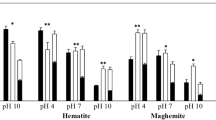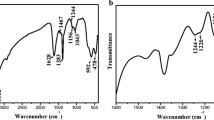Abstract
Potentiometric titration analysis was used to examine the hydrolysis behavior of Fe2+ Fe3+, and Al3+ in pure solution and in mixture, in order to evaluate the potential for coprecipitation and mixed solid-phase formation. Mixtures of Fe3+ and Al3+ did not interact during neutralization; base consumed in their respective buffer regions was equivalent to the total metal added. Fe2+-Al3+ solutions, however, showed excess base consumption in the Al3+ buffer region, indicating hydrolysis of Fe2+ at lower than normal pH. Ferric/ferrous iron analyses of systems at the Al endpoint (pH 5.5) showed amounts of oxidized Fe equivalent to the excess base consumption (∼10% of total Fe), with substantial amounts of Fe2+ sorbed to or occluded within Al polymers present. Increased electrolyte levels or the presence of SO42- inhibited oxidation and sorption of Fe2+ on Al surfaces, suggesting that Fe hydrolysis and oxidation was catalyzed at the surfaces. Increasing Al3+: Fe2+ ratios in the titrated solutions also increased the amount of Fe2+ coprecipitation, supporting a surface-mediated reaction mechanism. Ferrous iron oxidation was sensitive to O2 levels, which also affected the amount of coprecipitation. These findings suggest that surface-facilitated oxidation of Fe2+ may be important in the formation of mixed Fe-Al mineral phases in dilute soil solutions.
Similar content being viewed by others
References
Arden, T. V. (1950) The solubility of ferrous and ferrosic hydroxides: J. Chem. Soc, 882–885.
Baes, C. P. and Mesmer, R. E. (1976) The Hydrolysis of Cations: Wiley, New York, 228–237.
Barnhisel, R. I. and Bertsch, P. M. (1982) Aluminum: in Methods of Soil Analysis, Part 2, 2nd ed., A. L. Page, ed., American Society of Agronomy, Madison, Wisconsin, 275–297.
Chen, M. and Davidson, N. (1955) The kinetics of oxygenation of ferrous iron in phosphoric acid solution: J. Amer. Chem. Soc. 77, 793–798.
Fey, M. V. and Dixon, J. B. (1981) Synthesis and properties of poorly crystalline hydrated aluminous goethites: Clays & Clay Minerals 29, 91–100.
Gerstl, Z. and Banin, A. (1980) Fe+2-Fe+3 transformations in clay and resin ion-exchange systems: Clays & Clay Minerals 28, 335–345.
Millero, F. J. (1985) The effect of ionic interactions on the oxidation of metals in natural waters: Geochim. Cosmo-chim. Acta 49, 547–553.
Misawa, T., Hashimoto, K., and Shimodarra, S. (1973) Formation of Fe(II)-Fe(III) intermediate green complex on oxidation of ferrous iron in neutral and slightly alkaline sulfate solutions: J. Inorg. Nucl. Chem. 35, 4167–4174.
Schwertmann, U. and Taylor, R. M. (1977) Iron oxides: in Minerals in Soil Environments, J. B. Dixon and S. B. Weed, eds., Soil Science Society of America, Madison, Wisconsin, 145–180.
Sposito, G. and Mattigod, S. V. (1980) GEOCHEM. Dept. Soil and Environ. Sci., Univ. California, Riverside, California.
Stucki, J. W. and Anderson, W. L. (1981) The quantitative assay of minerals for Fe+2 and Fe+3 using 1,10 phenanthroline: Soil Sci. Soc. Amer. J. 45, 663–637.
Stumm, W. and Morgan, J. J. (1981) Aquatic Chemistry: Wiley, New York, 465–469.
Sugimoto, T. and Matijevic, E. (1980) Formation of uniform spherical magnetite particles by crystallization from ferrous hydroxide gels: J. Colloid Interf. Sci. 74, 227–243.
Sung, W. and Morgan, J. J. (1980) Kinetics and product of ferrous iron oxygenation in aqueous solutions: Environ. Sci. Tech. 14, 561–568.
Taylor, R. M. (1984) The rapid formation of crystalline double hydroxy salts and other compounds by controlled hydrolysis: Clay Miner. 19, 591–603.
Taylor, R. M. and McKenzie, R. M. (1980) The influence of aluminum on iron oxides. VI. The formation of Fe(II)-Al(III) hydroxychlorides, sulfates, and carbonates as new members of the pyroaurite group and their significance in soils: Clays & Clay Minerals 128, 179–187.
Taylor, R. M. and Schwertmann, U. (1974) Maghemite in soils and its origin. II. Maghemite synthesis at ambient temperature and pH 7: Clay Miner. 10, 299–310.
Taylor, R. M. and Schwertmann, U. (1978) The influence of aluminum on iron oxides. I. The influence of Al on Fe oxide formation from the Fe(II) system: Clays & Clay Minerals 26, 373–383.
Tronc, E. and Jolivet, J.-P. (1984) Exchange and redox reactions at the interface of spinel-like iron oxide colloids in solution: Fe(II) absorption: Absorp. Sci. Tech., 247–251.
Author information
Authors and Affiliations
Rights and permissions
About this article
Cite this article
Bertsch, P.M., Miller, W.P., Anderson, M.A. et al. Coprecipitation of Iron and Aluminum During Titration of Mixed AP+, Fe3+, and Fe2+ Solutions. Clays Clay Miner. 37, 12–18 (1989). https://doi.org/10.1346/CCMN.1989.0370102
Received:
Accepted:
Published:
Issue Date:
DOI: https://doi.org/10.1346/CCMN.1989.0370102




